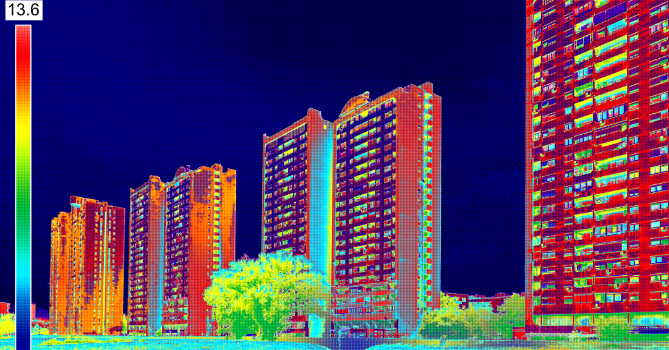
Unveiling the Power of Thermal Imaging for Sustainable Architecture
Hey there! Welcome to our blog all about thermal imaging and sustainability. Today, we're diving into the fascinating world of how thermal imaging technology is paving the way for greener, more energy-efficient buildings.
In this article, we'll explore the ins and outs of thermal imaging – what it is, how it works, and why it's so important for creating sustainable architecture. Whether you're an architect, a builder, or just someone curious about the latest innovations in green building practices, you're in the right place.
So, grab a cup of coffee and get cozy, because we're about to embark on a journey through the world of thermal imaging and its role in building a brighter, more sustainable future. From identifying energy leaks to optimizing building performance, thermal imaging is changing the game when it comes to eco-friendly design.
Ready to learn more? Let's dive in!
Thermal imaging is like having superpowers for spotting heat. It's a fancy term for using special cameras to capture images of heat energy emitted by objects. But don't worry, you don't need X-ray vision to understand it!
Here's how it works: Everything gives off heat, even things we can't see with our eyes. Thermal cameras pick up this heat energy and turn it into images that show us where hot spots are. It's kind of like seeing the world in a whole new light – or, rather, heat!
Now, you might be wondering, why is this important for sustainability? Well, think about it: In buildings, heat leaks can be a big problem. They waste energy and drive up utility bills. That's where thermal imaging comes in handy. By pinpointing these leaks, architects and builders can make buildings more energy-efficient and eco-friendly.
But thermal imaging isn't just for finding leaks. It can also help with things like detecting moisture damage, identifying electrical problems, and even spotting pests hiding in walls. It's like having a secret weapon for building inspections!
So, whether you're designing a new building or giving an old one a makeover, thermal imaging is a powerful tool for creating sustainable, comfortable spaces. With its ability to see what the naked eye can't, thermal imaging is helping architects and builders make a real difference in the fight against energy waste and environmental harm.

Thermal imaging isn't just cool technology – it's a game-changer for sustainable architecture. Let's break down some of the key benefits:
First off, thermal imaging helps architects and builders identify energy inefficiencies like a pro. By spotting heat leaks and insulation deficiencies, thermal imaging allows them to make targeted improvements that save energy and money. Think of it as finding and fixing hidden energy vampires lurking in your walls!
But that's not all – thermal imaging also improves occupant comfort. By identifying areas of heat loss or gain, architects can design buildings that stay cozy in the winter and cool in the summer. No more shivering in drafty rooms or sweating through heat waves – thermal imaging helps keep temperatures just right.
Plus, thermal imaging is a cost-effective way to optimize building performance. By making targeted energy-saving upgrades based on thermal imaging data, architects and builders can reduce utility bills and increase property value. It's like getting a return on investment while also saving the planet – talk about a win-win!
And let's not forget about the environmental benefits. By making buildings more energy-efficient, thermal imaging helps reduce greenhouse gas emissions and combat climate change. It's like giving Mother Nature a helping hand by making buildings that use less energy and produce fewer emissions.
But perhaps the biggest benefit of all is the peace of mind that comes with knowing your building is as energy-efficient as possible. With thermal imaging, architects and builders can confidently create spaces that are not only beautiful and comfortable but also sustainable and environmentally friendly. And that's something we can all feel good about.
Let's take a closer look at how thermal imaging is making a real difference in sustainable architecture through some exciting case studies:
First up, we have the renovation of a historic building in downtown Seattle. Using thermal imaging technology, architects identified areas of heat loss and poor insulation, allowing them to prioritize energy-saving upgrades. By making targeted improvements based on thermal imaging data, the building's energy efficiency was significantly improved, resulting in lower utility bills and a more comfortable indoor environment for occupants.
Next, let's head to a residential development in California. Here, thermal imaging was used to conduct energy audits on newly constructed homes. By identifying energy inefficiencies early on, builders were able to make cost-effective improvements that enhanced the energy performance of the homes. As a result, residents enjoyed lower energy bills and a reduced environmental footprint.

But thermal imaging isn't just for buildings – it can also be used to improve infrastructure. In a recent project, engineers used thermal imaging drones to inspect bridges for structural defects. By detecting areas of heat buildup, they were able to identify potential issues before they became serious problems, saving time and money on maintenance and repairs.
Finally, let's talk about a commercial office building in New York City. Thermal imaging was used to monitor the building's HVAC systems for efficiency and performance. By regularly conducting thermal scans, facility managers were able to identify and address issues such as air leaks and equipment malfunctions, resulting in improved comfort for occupants and reduced energy consumption.
These case studies illustrate the diverse applications of thermal imaging in sustainable architecture and highlight the tangible benefits it brings to building owners, occupants, and the environment. By harnessing the power of thermal imaging technology, architects and builders can create buildings that are not only beautiful and functional but also energy-efficient and environmentally friendly.
As technology continues to advance, so too does the field of thermal imaging. Here are some exciting innovations and trends to look out for in the future:
Advancements in sensor technology: As sensors become smaller, cheaper, and more powerful, we can expect to see improvements in thermal imaging cameras. This could lead to higher resolution images, enhanced sensitivity, and greater accuracy in detecting thermal anomalies.
Integration with artificial intelligence (AI): AI-powered algorithms have the potential to revolutionize thermal imaging analysis. By leveraging machine learning techniques, thermal imaging systems can automatically identify and classify thermal patterns, making it easier for architects and builders to interpret and act on thermal data.
Expansion into new applications: While thermal imaging has traditionally been used for building inspections and energy audits, we can expect to see it being adopted in new areas. For example, thermal imaging drones could be used for monitoring wildlife populations, detecting forest fires, or even identifying heat leaks in industrial equipment.
Integration with other technologies: Thermal imaging is likely to be integrated with other emerging technologies, such as augmented reality (AR) and virtual reality (VR). This could enable architects and builders to visualize thermal data in immersive 3D environments, facilitating more informed decision-making and problem-solving.
Miniaturization and portability: As thermal imaging cameras become smaller and more portable, we can expect to see them being used in a wider range of applications. From smartphones with built-in thermal cameras to wearable devices for personal safety, thermal imaging technology is becoming increasingly accessible to consumers.
Overall, the future of thermal imaging looks bright, with exciting innovations on the horizon that promise to further enhance its capabilities and expand its applications in sustainable architecture and beyond.
In conclusion, thermal imaging technology is paving the way for a more sustainable future in architecture. With its ability to identify energy inefficiencies, optimize building performance, and enhance occupant comfort, thermal imaging is revolutionizing the way architects and builders approach sustainable design.
As we look to the future, the potential of thermal imaging technology is limitless. With advancements in sensor technology, artificial intelligence, and integration with other emerging technologies, we can expect to see even greater innovations in the years to come.
But perhaps the most exciting aspect of thermal imaging is its ability to make a tangible difference in the world. By creating buildings that are not only beautiful and functional but also energy-efficient and environmentally friendly, architects and builders are helping to create a more sustainable and resilient built environment for future generations.
So, whether you're designing a new building or renovating an existing one, consider harnessing the power of thermal imaging to create spaces that are not only good for the planet but also good for the people who inhabit them.